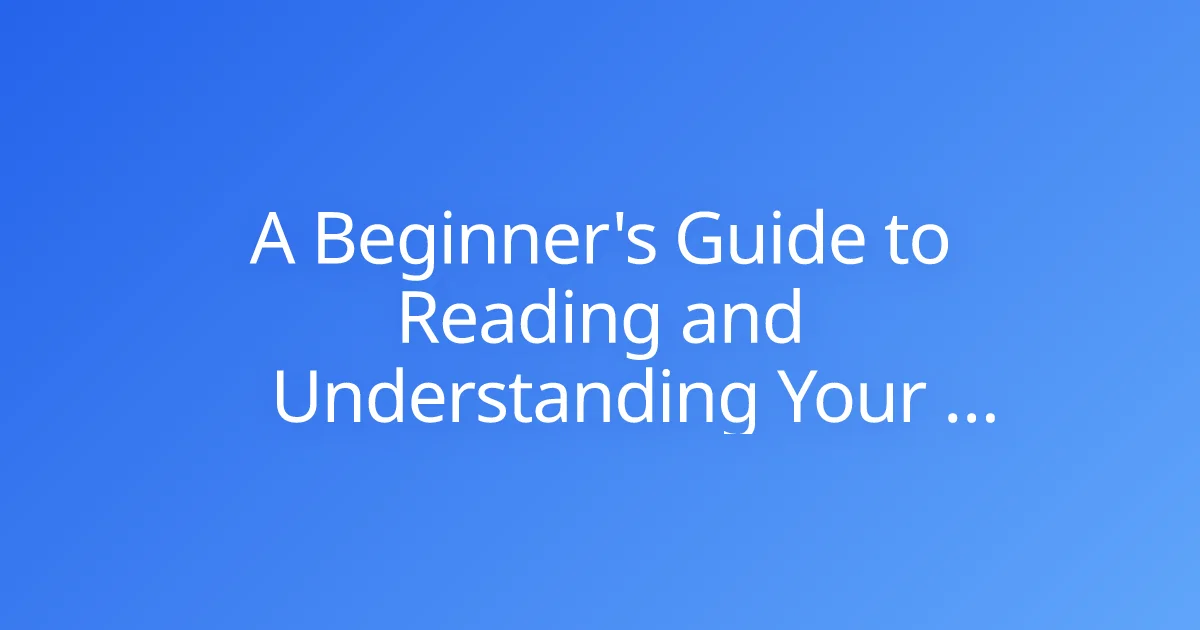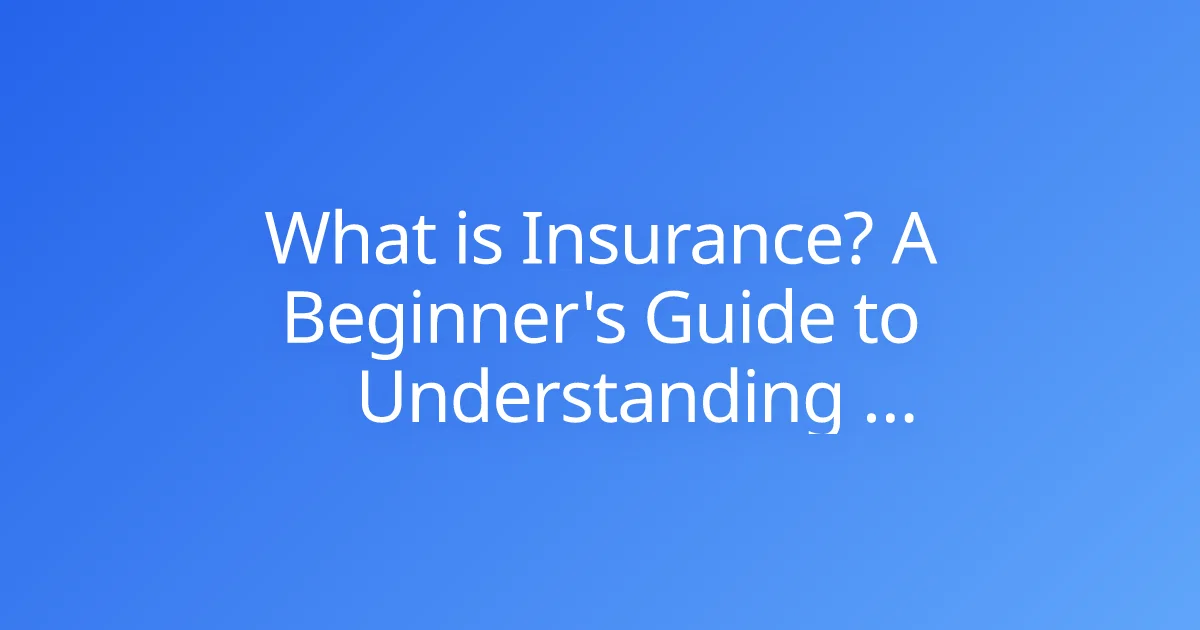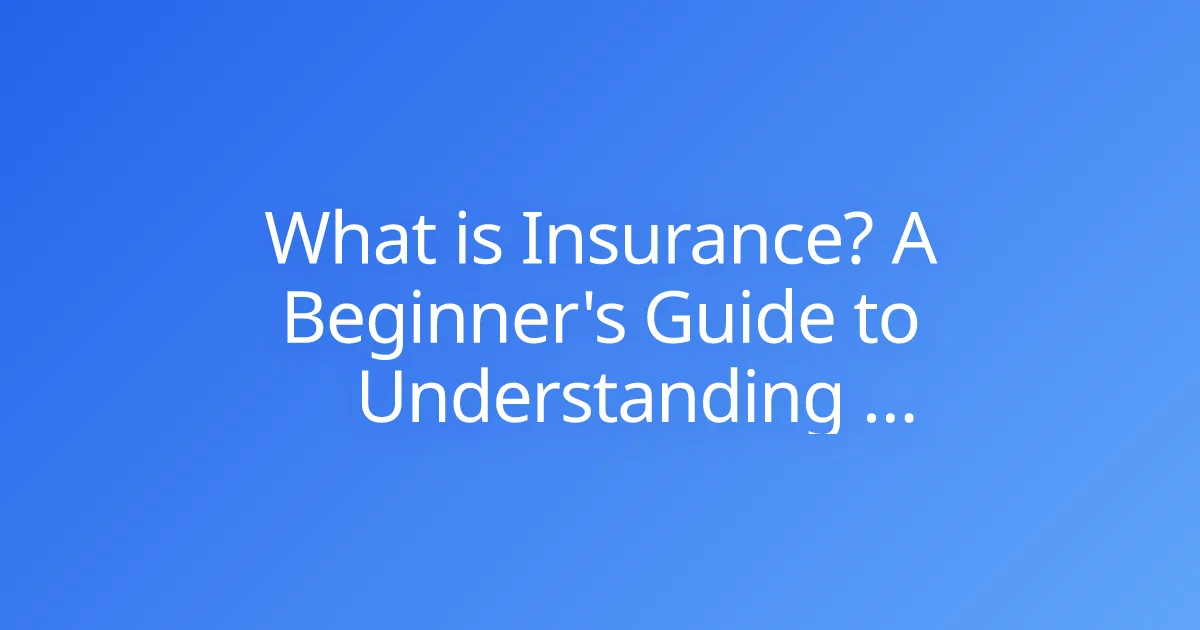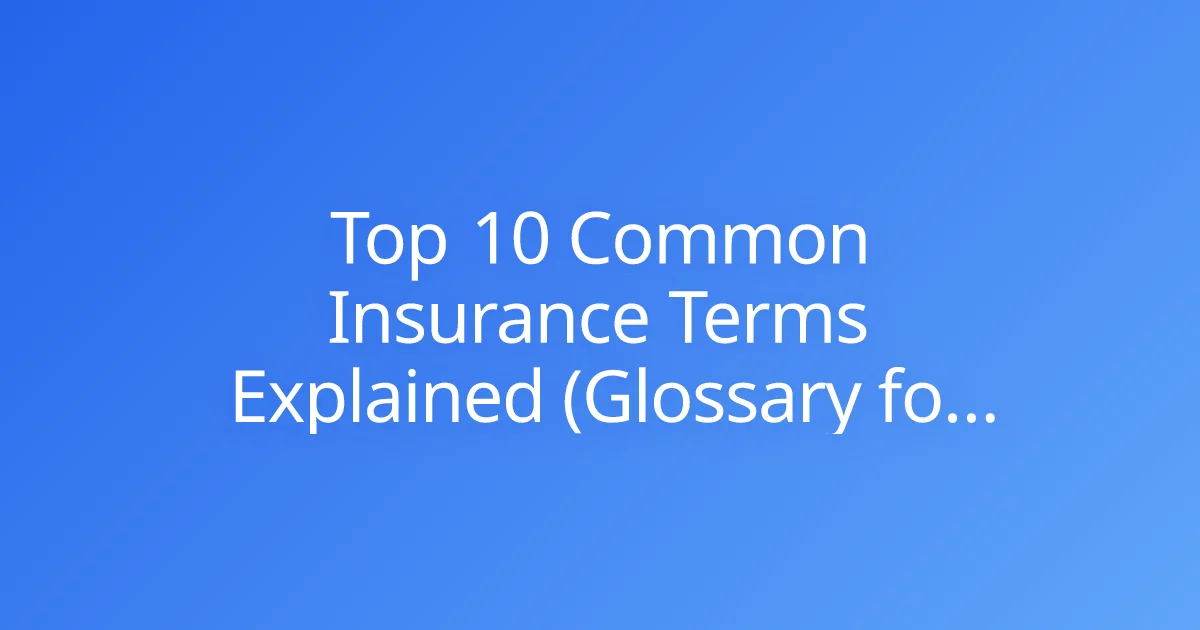A Beginner's Guide to Reading and Understanding Your Insurance Policy
Do you find yourself glazing over when faced with pages of dense insurance jargon? That thick packet of documents, seemingly written in a language all its own, is your insurance policy. While it might seem daunting, understanding your insurance policy is one of the most crucial steps you can take to protect your finances and ensure peace of mind. According to a 2024 Insurance Information Institute study, only 38% of Americans fully understand their insurance coverage, leaving billions in potential claim denials due to policy misunderstandings.
This comprehensive guide from The Policy Explainer is designed to demystify the process of reading and understanding your insurance policy in 2025. We'll break down its core components, explain the common terminology, and provide a clear, step-by-step approach to help you confidently navigate your coverage. By the end, you'll feel empowered to know exactly what your policy covers, what it doesn't, and what your responsibilities are.
Why Understanding Your Policy Is Non-Negotiable in 2025
Ignoring your insurance policy's details can lead to costly surprises. Truly understanding the document in your hand is fundamental for several reasons:
Avoiding Costly Surprises and Claim Denials
Imagine an unfortunate event occurs, and you file a claim, only to discover that the damage isn't covered or that your deductible is far higher than you anticipated. In 2024, the National Association of Insurance Commissioners reported that 22% of homeowners insurance claims were partially or fully denied due to policy misunderstandings. Such scenarios can add significant financial stress to an already difficult situation.
Real Example: Sarah from Denver thought her homeowners insurance covered all water damage. When a sump pump failure flooded her basement causing $18,000 in damage, she discovered her policy excluded backup water damage. She ended up paying the full cost out of pocket because she hadn't read her policy's exclusions section or purchased the $47/year endorsement that would have covered it.
By proactively understanding your insurance policy, you can identify gaps in coverage, anticipate out-of-pocket costs, and prevent unexpected financial burdens. Knowing your policy's limitations and exclusions upfront allows you to plan accordingly or seek additional coverage.
Exercising Your Rights as a Policyholder
Your insurance policy is a contract. It outlines not only the insurer's obligations but also your rights as a policyholder. If you're unfamiliar with these terms, you might miss out on benefits you're entitled to or fail to meet a condition that could jeopardize a claim. Understanding your policy empowers you to hold your insurer accountable and ensure you receive the protection you paid for.
With AI-powered claims processing becoming standard in 2025, knowing your policy details helps you verify automated decisions are correct. Industry data shows that 15% of AI-processed claims initially miss applicable coverage that policyholders successfully appeal.
Making Informed Decisions and Saving Money
Whether you're shopping for new coverage, renewing an existing policy, or considering a claim, a solid grasp of your insurance policy enables you to make smarter financial decisions. You'll be able to compare offers accurately, choose the right coverage limits, and select deductibles that align with your budget and risk tolerance.
Money-Saving Insight: Consumers who thoroughly review their policies before renewal save an average of $784 annually by identifying unnecessary coverages, optimizing deductibles, and discovering missed discounts, according to 2024 J.D. Power research.
The Core Components of Every Insurance Policy
While each type of insurance policy (auto, home, health, life) has its unique specifics, most share a common structural blueprint. Learning to identify these universal sections is key to decoding your insurance policy.
Declarations Page: Your Policy's Snapshot
This is usually the first page of your policy and acts as a quick summary. It contains the most crucial information in an easy-to-read format.
- Policyholder Information: Your name, address, and contact details
- Policy Number: A unique identifier for your specific policy
- Policy Period: The effective start and end dates of your coverage
- Premium: The total cost for your coverage, often broken down by payment schedule (monthly, annually)
- Coverage Types and Limits: A concise list of the specific coverages you've purchased (e.g., liability, collision, comprehensive) and the maximum amount the insurer will pay for each
- Deductibles: The amount you must pay out-of-pocket before your insurance coverage kicks in for a claim
Pro Tip: In 2025, many insurers provide digital declarations pages through mobile apps that update in real-time when you make policy changes. Take a screenshot of your declarations page and keep it accessible on your phone for emergencies.
Insuring Agreement: The Promise of Coverage
This section outlines the basic promise the insurance company makes to you. It describes the perils or events that the policy will cover and what the insurer agrees to pay for, subject to the policy's limits, conditions, and exclusions. It's often broadly worded, setting the stage for the more detailed sections.
Definitions: Demystifying the Jargon
Insurance policies are full of specialized terms. This section provides precise definitions for words and phrases used throughout the document (e.g., "insured," "occurrence," "bodily injury," "property damage," "actual cash value," "replacement cost"). Taking the time to read these definitions is critical, as they clarify the scope and limitations of your coverage.
Common Misunderstanding: The term "dwelling" in homeowners insurance doesn't include detached structures like sheds or fences—those fall under "other structures" coverage with separate limits.
Exclusions: What's NOT Covered
This is one of the most vital sections to understand. Exclusions explicitly list the specific events, types of damage, or circumstances for which your policy will not provide coverage. Common exclusions include:
- Home Insurance: Flood damage, earthquake damage (often requires separate policies), intentional damage, damage from neglect, mold (in many policies)
- Auto Insurance: Intentional acts, damage from racing, wear and tear, using vehicle for commercial purposes without proper coverage
- Health Insurance: Cosmetic procedures (unless medically necessary), experimental treatments, services from out-of-network providers (depending on plan type)
2025 Update: Many insurers now offer cyber insurance endorsements for homeowners policies, covering identity theft and cyber extortion, which were traditionally excluded. Ask your agent about these new options.
Thoroughly reviewing exclusions prevents unpleasant surprises when filing a claim.
Conditions: Your Responsibilities
This section details the duties and obligations of both the policyholder and the insurer. For you, the policyholder, conditions might include:
- Paying Premiums on Time: Failure to do so can lead to policy cancellation
- Reporting Claims Promptly: There are often time limits for notifying your insurer after an incident
- Cooperating with the Insurer: Providing necessary documentation, participating in investigations
- Maintaining the Insured Property: Keeping your home in good repair to prevent further damage
- Notification of Material Changes: Informing your insurer of changes like renovations, new drivers, or starting a home business
Failing to meet these conditions could impact your ability to receive a payout on a claim.
Endorsements or Riders: Customizing Your Coverage
These are additions or modifications to the standard policy. They can either add new coverages or modify existing ones. For example:
- Homeowners: A "scheduled personal property" endorsement might add specific coverage for valuable jewelry or art
- Auto: A "rental car reimbursement" endorsement would cover the cost of a rental car after a covered accident
- Health: Riders might cover specific benefits not included in the base plan
Endorsements allow you to tailor your insurance coverage to your unique needs. In 2025, digital-first insurers offer one-click endorsement additions through mobile apps, making customization easier than ever.
A Step-by-Step Approach to Reading Your Policy
Instead of feeling overwhelmed, approach your policy systematically. Here's how to read and understand your insurance documents effectively:
Step 1: Start with the Declarations Page
Always begin here. It's your personalized summary. Confirm that all personal details are correct, that the coverage limits and deductibles match what you discussed or remember choosing, and that the policy dates are accurate. This page provides a quick overview of what you're paying for.
Checklist for Declarations Page:
- Verify all names and addresses are correct
- Confirm coverage limits match your assets
- Check deductibles align with your emergency fund
- Validate policy effective dates
- Review premium amount and payment schedule
Step 2: Grasp the Definitions
Before diving into the core agreements, turn to the definitions section. Make sure you understand how key terms are defined within the context of your specific policy. This foundational understanding will prevent misinterpretations of the insuring agreement and exclusions.
Time-Saving Tip: Create a personal glossary of the top 10 terms that appear most frequently in your specific policy. This quick reference will help when reviewing claims or making policy decisions.
Step 3: Analyze the Insuring Agreement and Exclusions Together
Read these two sections together. The insuring agreement tells you what's generally covered, while the exclusions tell you what's specifically left out. Pay close attention to how these sections interact.
Example: A home policy might cover "sudden and accidental water damage" but exclude "damage from floods" – the definitions and exclusions clarify the difference. Flood is defined as surface water accumulation, while burst pipes are sudden and accidental.
Step 4: Understand the Conditions and Your Duties
Know what's expected of you. This is crucial for avoiding situations where your claim might be denied due to non-compliance with policy terms. Note down any specific timeframes for reporting claims or maintaining records.
Critical Deadlines to Note:
- Claim reporting timeframe (typically 24-72 hours for theft/vandalism)
- Proof of loss submission deadline
- Annual policy review date
- Premium payment due dates
Step 5: Review All Endorsements
Don't skip the riders! These often contain critical additions or limitations to your coverage. Ensure they reflect any specific additions or changes you requested or were advised to consider.
Step 6: Use Digital Tools in 2025
Take advantage of modern technology to understand your policy better:
- Mobile Apps: Most major insurers now offer apps with policy details, ID cards, and claim filing capabilities
- AI Policy Analyzers: Some insurtech companies offer free tools that analyze your policy and identify gaps or savings opportunities
- Digital Document Organization: Use cloud storage to keep all policy documents, endorsements, and correspondence organized and accessible
Key Questions Your Policy Should Answer
As you read through your insurance policy, keep these fundamental questions in mind. If you can answer them, you're on the path to true insurance policy understanding:
What is covered, and for how much?
Identify the types of perils or incidents your policy protects against (e.g., fire, theft, liability, medical expenses). Then, locate the corresponding coverage limits, which state the maximum amount your insurer will pay for a covered loss.
2025 Coverage Adequacy Check:
- Auto: Does your liability coverage match your net worth to protect assets from lawsuits?
- Home: Is your dwelling coverage at least 80% of replacement cost (required by most policies to avoid coinsurance penalties)?
- Health: Do your coverage limits account for rising medical costs (hospital stays now average $2,883/day in 2024)?
What is explicitly not covered?
Revisit the exclusions. Are there any significant gaps in coverage that you weren't aware of? For example, does your home insurance cover hail damage, or is it excluded in your region? Knowing what's not covered is as important as knowing what is.
Common Gaps: Standard policies typically exclude: floods, earthquakes, backup water damage, home business liability, cyber attacks, and mold (beyond limited amounts).
When does coverage begin and end?
Check the policy period on the declarations page. This clarifies the exact dates your coverage is active. It's crucial for understanding continuity of protection, especially during renewals or when switching providers.
How much will I pay out-of-pocket (deductibles, copays)?
Locate your deductibles for each type of coverage. For health insurance, understand your copays and coinsurance, and identify your annual out-of-pocket maximum. This prepares you for the financial responsibility you'll bear before your insurer steps in.
Deductible Strategy: Financial experts recommend setting deductibles at an amount you could pay from your emergency fund without hardship. The 2024 average emergency fund is $8,000, making a $1,000-$2,000 deductible appropriate for most households.
What are my responsibilities as a policyholder?
Review the conditions. Are you required to notify the insurer of certain changes, maintain specific safety features, or provide documents within a particular timeframe after a loss? Fulfilling your obligations ensures your policy remains valid.
How do I file a claim?
While not always a specific section, the conditions or a dedicated "How to File a Claim" section will provide instructions. Knowing the process (who to call, what information you need, typical timelines) streamlines a potentially stressful situation.
2025 Claims Process: Most insurers now offer:
- 24/7 mobile app claim filing with photo upload
- AI-powered initial damage assessment
- Real-time claim status tracking
- Direct payment options (ACH, Venmo, PayPal)
2025 Trends Transforming Insurance Policies
Digital-First Policy Documents
Traditional paper policies are giving way to interactive digital documents. In 2025, leading insurers offer:
- Interactive PDFs with clickable sections and embedded video explanations
- Mobile-optimized policy documents with search functions
- Plain-language summaries generated by AI alongside legal policy language
- Real-time updates when coverage or premiums change
Adoption Rate: 67% of policyholders under 45 now prefer digital-only policy documents, according to a 2024 Accenture study.
AI-Powered Policy Assistance
Insurers are deploying AI chatbots and virtual assistants that can:
- Answer questions about your specific policy 24/7
- Explain complex terms in simple language
- Identify potential coverage gaps
- Suggest appropriate endorsements based on your life situation
Example: State Farm's "Virtual Assistant" can explain why a claim might be denied before you file it, helping policyholders understand exclusions proactively.
Usage-Based and On-Demand Coverage
Insurance is becoming more flexible:
- Telematics for Auto: Pay-per-mile insurance saves careful drivers an average of $489/year
- Smart Home Integration: Discounts for connected devices that prevent losses (smart water sensors, security systems)
- On-Demand Coverage: Activate additional coverage only when needed (vacation coverage, special event liability)
Embedded Insurance
Insurance is being built directly into purchases:
- Buy a phone, automatically get device insurance option
- Book travel, instantly add trip cancellation coverage
- Rent equipment, coverage included in rental price
This trend makes understanding what's included vs. what requires separate coverage more important than ever.
Money-Saving Policy Review Checklist
Use this checklist annually to ensure you're getting maximum value from your insurance:
- Review Coverage Limits: Do they still match your asset values?
- Assess Deductibles: Can you raise them to lower premiums based on your improved emergency fund?
- Verify Discounts: Are you getting all eligible discounts (bundling, safety features, good student, professional associations)?
- Check for Duplicate Coverage: Are you paying for rental car coverage on both credit cards and insurance?
- Evaluate Endorsements: Do you still need all riders, or are some no longer relevant?
- Compare Quotes: Get quotes from 3-5 competitors to ensure competitive pricing
- Review Exclusions: Have any new exclusions been added at renewal?
- Update Personal Information: Has your address, vehicles, or household composition changed?
Average Savings: Policyholders who complete this annual review save an average of $784/year, according to 2024 Insurance Research Council data.
Tips for Deeper Understanding and Better Management
Beyond just reading, here are some expert tips for better insurance policy management and comprehension:
Don't Be Afraid to Ask Questions
If any part of your policy is unclear, contact your insurance agent, broker, or the insurance company directly. They are there to help you understand your coverage. Ask for explanations in plain language and don't hesitate to ask for examples.
Script for Agent Call: "I'm reviewing my policy and want to make sure I understand [specific section]. Can you explain what this means in practical terms, and give me an example of when this coverage would or wouldn't apply?"
Keep Your Policy Documents Organized
Whether in a physical binder or digital folder, keep all your policy documents, including declarations pages, endorsements, and correspondence, in an easily accessible place. This will save you time and stress if you need to reference them or file a claim.
Digital Organization System:
- Main folder: "Insurance Policies"
- Subfolders by type: Auto, Home, Health, Life
- Each subfolder: Current Policy, Previous Policies, Claims History, Correspondence
- Use cloud storage for access anywhere
Review Your Policy Annually (Minimum)
Life circumstances change, and so should your insurance needs. Annually, perhaps at renewal time, take a few minutes to review your policy. Have you acquired new assets? Has your family situation changed? Are there new risks to consider? This ensures your coverage remains adequate and cost-effective.
Life Events Requiring Immediate Policy Review:
- Marriage or divorce
- Birth or adoption of child
- Home purchase or major renovation
- Starting a business
- Significant income change
- Adding teen driver
- Retirement
Document Communications
Whenever you speak with your insurance provider, note down the date, time, who you spoke with, and what was discussed. If making significant changes, request written confirmation. This creates a valuable paper trail for future reference.
Best Practice: Follow up every phone call with an email summarizing the conversation: "Per our conversation on [date], my understanding is [summary]. Please confirm or correct."
Use Technology to Your Advantage
In 2025, leverage these tools:
- Policy Management Apps: Centralize all insurance policies in one place
- Claim Cost Estimators: Many insurer apps now let you estimate claim costs before filing
- Coverage Calculators: Determine appropriate coverage limits based on your assets
- Discount Finders: Some apps automatically identify discounts you're eligible for but not receiving
Common Policy Reading Mistakes to Avoid
Mistake #1: Ignoring the Exclusions Section
Many policyholders focus only on what's covered and skip the exclusions. This leads to claim denials that could have been avoided.
Solution: Spend as much time reading exclusions as you do reading coverages. For every "yes" in coverage, understand the "no's" in exclusions.
Mistake #2: Assuming "Full Coverage" Means Everything
There's no such thing as "full coverage" in insurance. All policies have limits and exclusions.
Solution: Ask specifically: "What are the main things this policy doesn't cover?" and "Are there any sub-limits I should know about?"
Mistake #3: Not Reading Endorsements
Many people sign endorsements without reading them, assuming they're just adding coverage. Some endorsements actually remove coverage.
Solution: Read every endorsement completely. Ask why it's being added and what it changes about your base policy.
Mistake #4: Waiting Until a Claim to Read Your Policy
Reading your policy for the first time during a stressful claim situation is a recipe for disappointment.
Solution: Schedule a "policy reading date" annually, preferably 30 days before renewal when you can still make changes.
Mistake #5: Not Asking About Coverage Scenarios
Policy language can be ambiguous. What matters is how it applies to real situations.
Solution: Ask your agent about specific scenarios: "If X happens, am I covered?" "What would my out-of-pocket cost be if Y occurs?"
Frequently Asked Questions
How long does it take to thoroughly read an insurance policy?
Plan for 30-45 minutes for a typical personal insurance policy (auto or home). Health insurance policies, especially with multiple coverage tiers, may take 60-90 minutes. Don't rush—this time investment can save thousands in avoided claim denials.
What should I do if I find terms I don't understand?
Create a list of unclear terms and schedule a call with your agent. Most agents are happy to do a policy walkthrough. You can also use insurer mobile apps—many now have AI assistants that can explain terms in plain language instantly.
Can I negotiate terms in my insurance policy?
Standard policy language is usually non-negotiable, but you can customize through endorsements, adjust coverage limits, and change deductibles. For high-value or commercial policies, some terms may be negotiable.
How often should I read my entire policy?
Read it thoroughly when you first purchase it, then review the declarations page and any changes at each renewal (annually). Do a complete re-read every 3-5 years or after major life changes.
What's the difference between declarations page and policy documents?
The declarations page is a summary of your specific coverage (limits, deductibles, premium). Policy documents contain the full legal contract including conditions, exclusions, and detailed definitions. Both are important, but the dec page is what you'll reference most frequently.
Are digital policies legally binding?
Yes. E-policies have the same legal weight as paper policies. In fact, 73% of insurers now issue policies digitally by default, with paper only upon request. Digital policies often include enhanced security features like encryption and blockchain verification.
What happens if my insurer changes policy terms mid-year?
Insurers generally cannot change coverage terms mid-policy period without your consent. Changes typically occur at renewal. You should receive a renewal notice 30-60 days before your policy expires, detailing any changes. This is your opportunity to accept, negotiate, or shop for a new policy.
Conclusion
Understanding your insurance policy is an empowering act that transforms a complex, seemingly intimidating document into a clear roadmap of your financial protection. By dedicating time to read and comprehend its core components—from the declarations page to the critical exclusions and conditions—you gain invaluable insight into what you're covered for and what your responsibilities are.
This knowledge protects you from costly surprises, ensures you can effectively claim your benefits, and allows you to make strategic decisions about your coverage. With 62% of Americans admitting they don't understand their insurance policies (2024 Insurance Information Institute), taking the time to truly comprehend yours puts you ahead of the curve.
In 2025, with digital tools, AI assistants, and mobile apps making policy information more accessible than ever, there's no excuse for insurance illiteracy. The average policy review takes just 45 minutes but can save you $784 annually and prevent thousands in unexpected out-of-pocket costs from claim denials.
Don't let insurance jargon stand between you and your peace of mind. Investing in this understanding is investing in your financial security. Remember: the best time to understand your policy is before you need to use it, not during a stressful claim situation.
Your Action Plan:
- Set aside 45 minutes this week to read your most important policy (home or auto)
- Create a list of questions for your agent
- Download your insurer's mobile app for easy policy access
- Set an annual calendar reminder for policy review
- Share this guide with family members who manage insurance
The protection you've paid for is only as good as your understanding of it. Take control of your coverage today.



